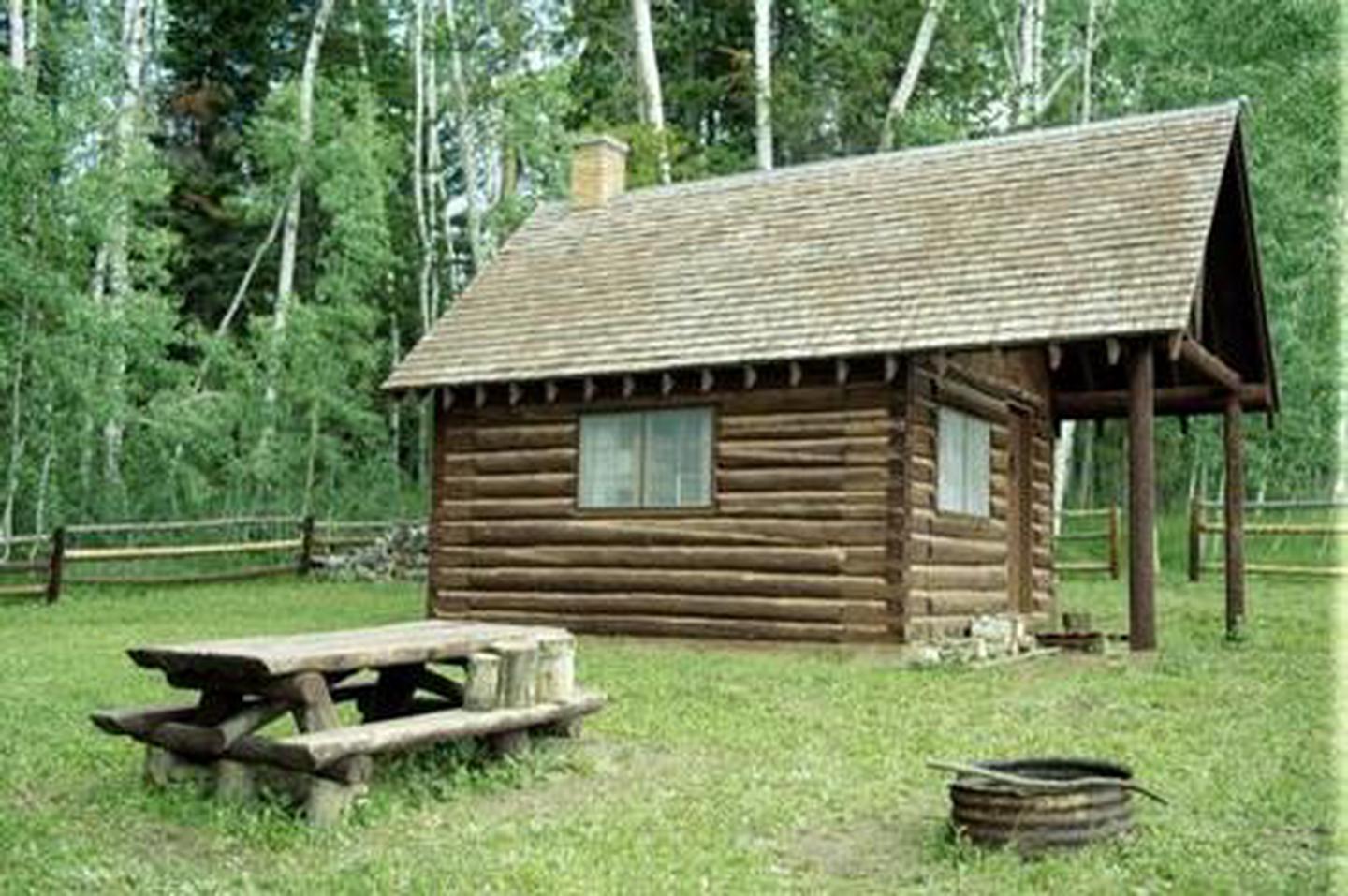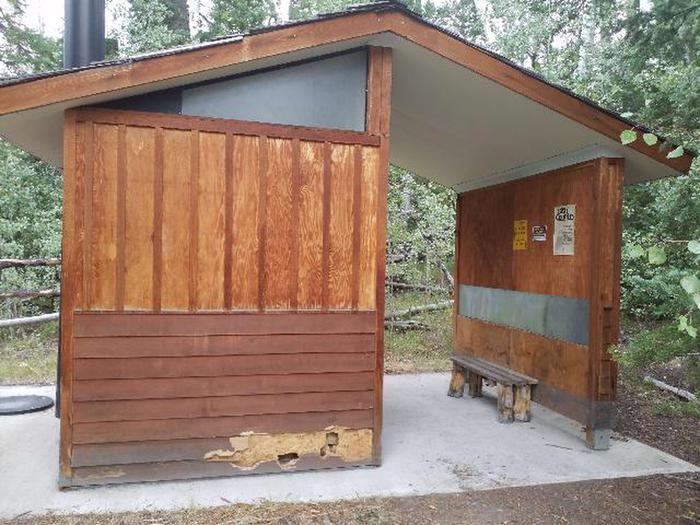Jack Creek Guard Station
Medicine Bow-Routt Nfs & Thunder Basin Ng
The Jack Creek Guard Station is available mid-June through October, weather permitting. This was the northern ranger cabin for the historic Encampment Ranger District, built by Ranger Evie Williams in 1934, and is listed on the National Register of Historic Places. The one-room cabin can accommodate up to four people with two bunk beds, a combination wood/propane cook stove, simple table and chairs. There is no indoor plumbing, a vault toilet is located within walking distances. Water is available during the summer months from the freeze-proof hydrant outside and from the Jack Creek Campground nearby. Items to bring include bedding/sleeping bag, food, dish soap and sponge, trash bags, first aid kit, flashlight, towels and washcloths, personal items. Basic cooking and eating utensils are provided. Utensils need to be cleaned and put away after use. The garbage is pack-in, pack-out. Saddle/ pack animals may not be be kept within the Jack Creek Guard Station area. Campers, tents or trailers may not be set up at this facility. Please clean up after your pets.
The Jack Creek Guard Station is located southwest of Saratoga, Wyoming, offering visitors a unique lodging experience in the Medicine Bow-Routt National Forests.
The guard station once served as the northern ranger cabin for the historic Encampment Ranger District. It was constructed by Ranger Evie Williams in 1934. Oral history states that Ranger Williams spent most of his construction dollars on the material for the foundation and chimney, and used his own funds to finish the windows and roof.
The guard station is now listed on the National Register of Historic Places and offers guests recreation and relaxation in a delightful natural setting. The cabin is typically open from mid-June through mid-October and is accessible by vehicle. Basic amenities are provided, but guests will need to pack in some of their own supplies and gear.
The one-room cabin is furnished with two sets of bunk beds and can accommodate up to four people. Heat is provided by a combination wood and propane cook stove. Basic cooking and eating utensils and propane lights are supplied.
Water is available during the summer months from a hydrant just outside or a hand pump at Jack Creek Campground, one mile away. There is no indoor plumbing, but a vault toilet is located nearby. A picnic table and campfire ring are also outside the cabin. Please use propane side of stove for cooking and heat. There is no trash service; this is a pack-it-in, pack-it-out facility.
Need to Know
Cell phone coverage in the area is unreliable.
Instructions for lighting the propane stove and lights are inside the cabin; guests need to open the propane tank valve to use and close it upon departure.
- No pets are allowed within the cabin; pets must be cleaned up after outside.
- No saddle or pack animals are allowed at this facility.
- Additional campers, trailers or tents cannot be set up at this facility.
- Guests need to provide their own food, sleeping bags, pillows, flashlights, towels, dish soap, matches, first aid kit, toilet paper and garbage bags.
- All trash and food must be packed out.
- Guests are expected to clean the cabin before leaving.
- Don't Move Firewood: Prevent the spread of tree-killing organisms by obtaining firewood at or near your destination and burning it on-site. For more information visit dontmovefirewood.org.
Check the elements
-What is in the skies? Check the weather report before you leave home. When you arrive at the site, keep on eye on the skies for changes and, if possible, carry a compact weather radio. In inclement weather, take shelter until the bad weather passes. Stay dry - wet clothes contribute to heat loss. Also, keep sleeping bags and important gear dry at all times.
-Are there forest or grassland alerts? Forest and grassland home pages post alerts you should know before you go. Many of our forests and grasslands also post alerts on Twitter. The latest fire information may be found on InciWeb.
Survey your surroundings
-Arrive early. Plan your trip so that you arrive at your actual campsite with enough daylight to check over the entire site and safely set up camp.
-Check for potential hazards. Be sure to check the site thoroughly for glass, sharp objects, branches, large ant beds, poison ivy, bees, and hazardous terrain.
-Avoid areas of natural hazards. Check the contour of the land and look for potential trouble spots due to rain or snow. Areas that could flood or become extremely muddy can pose a problem.
-Inspect the site. Look for a level site with enough room to spread out all your gear. A site that has trees or shrubs on the side of prevailing winds will help block strong, unexpected gusts.
-Pitch your tent in a safe spot. Make sure your tent is made of flame-retardant fabric, and keep it a safe distance away from campfires. Keep insects out of your tent by closing the entrance quickly when entering or leaving.
-Build fires in a safe area. Your open fires and fuel-burning appliances must be far enough away from the tent to prevent ignition from sparks, flames, and heat. Never use a flame or any other heating device inside a tent. Check to know whether there are fire restrictions in place before starting a campfire. You could be fined if you start a fire in a restricted area.
Be fire safe
-Keep fires small and bring firewood purchased in the local area. Firewood brought from another area could also bring invasive pests.
-If you have to collect firewood at your campsite, collect dead and down wood only.
-Check at the local ranger station for current fire restrictions, which can change on a daily, sometimes hourly, basis.
-Use existing fire rings. Scrape away litter and any other burnable material within a 10-foot-diameter surrounding the ring.
-Make sure all wood fits inside the fire ring. Do not feed a large log into the fire ring.
-Have a shovel, axe, and bucket of water available before lighting your campfire.
-Never leave a campfire unattended, even for a few minutes or even if there are no flames present. Many wildfires start because of abandoned fires or because someone thought a fire was out.
-Put out a campfire by slowly pouring water onto the fire and stirring with a shovel. Continue adding and stirring until all material is cool to touch.
-Do not bury your fire. The coals can smolder and re-ignite.
Be bear aware
Being outdoors means being with wildlife. Many people never encounter a bear. But if you do, here's some simple advice:
DO NOT RUN.
*Remain calm.
*Group together and pick up small children.
*Continue to face the bear and back away slowly, talking calmly to identify yourself as a human.
*If the bear continues to approach, try to scare it away by making yourself as large and imposing as possible by stretching your arms overhead and making loud noises.
*Carry and know how to use bear spray, which is available at many outdoor retailers and can be used to deter a charging bear.
Food Storage
Bears are always searching for food. Bears are curious, intelligent animals that have great memories. Their eyesight is similar to humans and their sense of smell is seven times more powerful than a blood hound’s, enabling them to smell food from miles away. Those are the very traits that can sometimes get them – and us – into trouble. Most bears are wary of humans and try to avoid them. However, bears can learn to associate people with food and be tenacious in their pursuit of something to eat. Even if humans are around.
Everyone in bear country must do our part to store food and other attractants in bear-resistant containers at all times, and dispose of trash in bear-resistant dumpsters.
Natural Features
From open, high expanses to valleys and canyons that rise steeply to snowy ranges, the Medicine Bow-Routt National Forests encompass mountain ranges, tributaries to the North Platte River and the Colorado River, and a mix of forested ecology with spruce, lodgepole pine, subalpine fir, aspen and shrub lands.
The Jack Creek Guard Station sits in a clearing with lodgepole pine, aspen and mixed conifer forest at an elevation of 8,500 feet. Wildlife viewing is abundant in the area, including elk, deer, bear and moose.
Nearby Attractions
Recreation
Lake and Pond Fishing
Areas for Lake and Pond Fishing at Sierra Madre Area
- Brush Creek/Hayden Ranger District Office
- Hog Park Boat Dock and Ramp
- Hog Park Campground
- Hog Park Picnic Site
- Lake View Picnic Site at Hog Park
River and Stream Fishing
Areas for River and Stream Fishing at Sierra Madre Area
- Big Creek-Holroyd Park Trailhead
- Bottle Creek Campground
- Bottle Creek Group Picnic Site
- Brush Creek/Hayden Ranger District Office
- East Fork - Encampment River Trail
- Encampment River Wilderness
- Hog Park Campground
- Huston Park Wilderness
- Jack Creek Campground
- Jack Creek Crew Quarters
- Jack Creek Guard Station
- Purgatory Gulch Trailhead
Day Hiking
Areas for Day Hiking at Sierra Madre Area
- Baby Lake Trailhead
- Big Creek Park Trailhead
- Big Creek-Holroyd Park Trailhead
- Bottle Creek Campground
- Bottle Creek Group Picnic Site
- Bottle Creek Trails
- Brush Creek/Hayden Ranger District Office
- CDNST - Deep Jack Trailhead
- CDNST - Pipeline Trailhead
- CDNST - Red Mountain Trailhead
- Commissary Park Trailhead
- East Fork - Encampment River Trail
- Encampment River Wilderness
- Green Mountain Falls Trailhead
- Green Mountain Trailhead
- Hog Park Campground
- Huston Park Wilderness
- Jack Creek Campground
- Jack Creek Crew Quarters
- Lost Creek Campground
- Purgatory Gulch Trailhead
Backpacking
Areas for Backpacking at Sierra Madre Area
- Baby Lake Trailhead
- Brush Creek/Hayden Ranger District Office
- CDNST - Deep Jack Trailhead
- CDNST - Pipeline Trailhead
- CDNST - Red Mountain Trailhead
- Commissary Park Trailhead
- East Fork - Encampment River Trail
- Encampment River Wilderness
- Green Mountain Trailhead
- Huston Park Wilderness
- Purgatory Gulch Trailhead
Viewing Wildlife
Areas for Viewing Wildlife at Sierra Madre Area
- Brush Creek/Hayden Ranger District Office
- Hog Park Campground
- Jack Creek Crew Quarters
- Jack Creek Guard Station
- Sandstone Cabin
Viewing Plants
Areas for Viewing Plants at Sierra Madre Area
- Brush Creek/Hayden Ranger District Office
- Hog Park Campground
- Jack Creek Crew Quarters
- Jack Creek Guard Station
Viewing Scenery
Areas for Viewing Scenery at Sierra Madre Area
- Brush Creek/Hayden Ranger District Office
- Encampment River Wilderness
- Green Mountain Falls Trailhead
- Hog Park Campground
- Huston Park Wilderness
Contact Information
Default
P.O. BOX 249 2171 S. HIGHWAY 130 SARATOGA WY 82331
Rental Options
Learn more about gear rental options for your trip
Driving Directions
From Saratoga, travel west on County Road 500 approximately 16 miles to junction with County Road 405. Stay left and travel 3 miles to the forest boundary. The road changes to Forest Service Road 452. Travel on Forest Service Road 452 for 6.5 miles to Jack Creek Campground and the guard station.
From Encampment, take State Highway 70 west for 7 miles and turn onto Forest Service Road 443 for approximately 15 miles to the junction of Forest Service Road 452. From there, go west for approximately 8 miles to Jack Creek Campground and the guard station.

